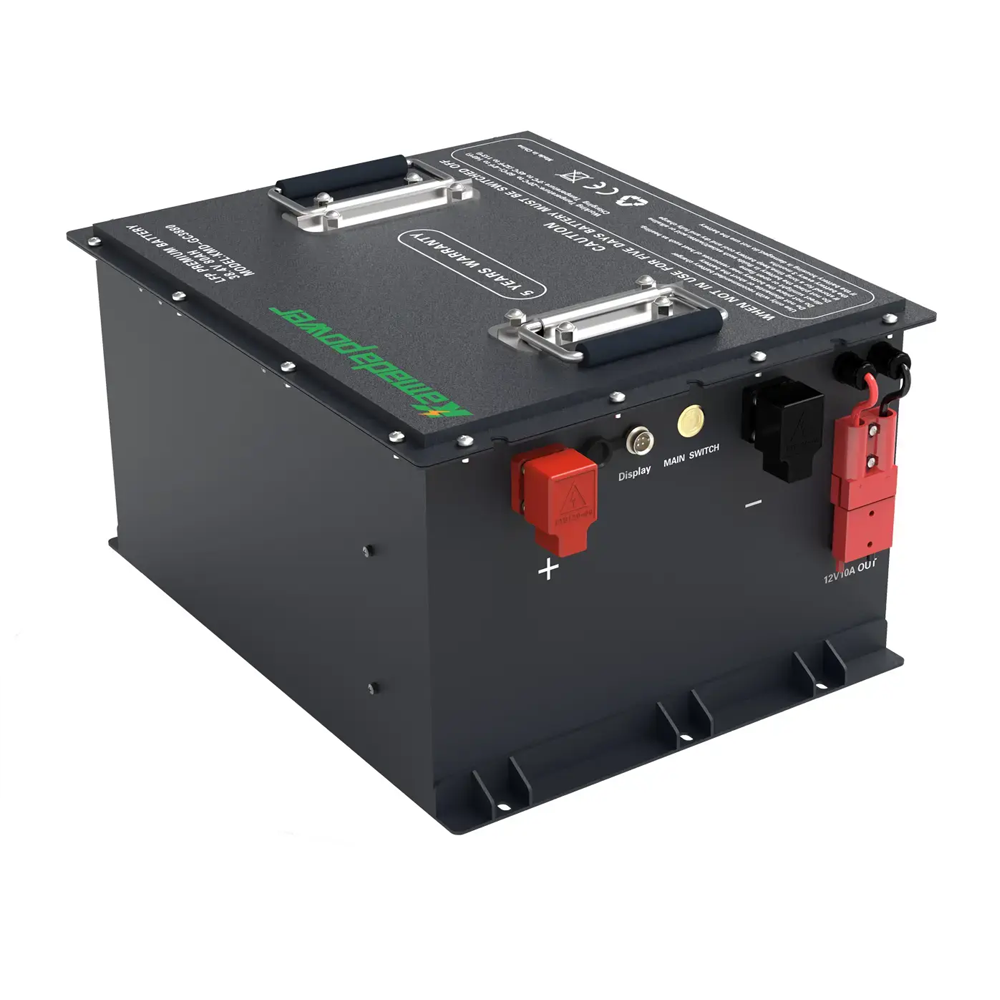またメンテナンス記録とにらめっこしている。カート#7が今月3度目のダウン。あなたのチームは何時間も水を撒き、端子の腐食を掃除し、300ポンドのバッテリーパックを交換している。一方、リゾートの宿泊客はカートの動きが鈍いと不満を漏らし、運営スタッフは1回の充電で1日の仕事をこなすことができない。ダウンタイムと生産性の低下という、よくあるイライラするサイクルだ。
もしこれがあなたの火曜日と同じように聞こえるなら、あなたはおそらくこう思ったことだろう:これらをリチウムに変えることはできるのだろうか?短い答えは「イエス」だ。しかし、他の本格的な機器のアップグレードと同様、詳細を正しく理解することが重要なのだ。

100Ah 48Vリチウムゴルフカートバッテリー
クラブカーにリチウムバッテリーを搭載することは可能だが、互換性が重要
旧式の浸水型鉛酸(FLA)バッテリーを最新のリチウムイオンパックに交換することは、クラブカーのフリートにできる最もインパクトのあるアップグレードの1つです。しかし、これは単純なドロップ・イン・アンド・ゴー・プロセスではありません。それは、新しいバッテリーシステムがカートの既存の電気系統と実際に通信できるかどうかです。
エンジンスワップと同じ理屈だ。4気筒用に作られたクルマにV8を無理やり搭載して、ベストを望むことはないだろう。トランスミッション、冷却装置、エレクトロニクスをアップグレードしなければならない。A 48Vリチウムゴルフカートバッテリー 安全で信頼できる性能を発揮するためには、適切なサポート部品が必要です。
リチウム電池にアップグレードする理由
リチウムの初期コストは高い。では、なぜ数え切れないほどの車両管理者や産業部門がリチウム電池に切り替えているのでしょうか?それは、総所有コスト(TCO)がはるかに低いことと、性能に一夜にして差が出るからだ。
産業界のクライアントとの直接の仕事から、その利点は否定できない:
- ゼロ・メンテナンス: バッテリーに水をやり、端子を掃除し、酸を扱う。これは大きな省力化だ。もういい。
- サイクル寿命が長い: 鉛酸パックは、完璧に扱えば500~1,000サイクル程度。高品質のリン酸鉄リチウム(LiFePO4)パックは、こうした用途の標準であり、3,000~5,000サイクル以上を実現する。これは何年にもわたる余分な寿命だ。
- 安定したパワー: 鉛蓄電池は巨大な問題を抱えている 電圧降下.リチウムパックが消耗すると、特に坂道でカートのスピードが落ちます。リチウムパックは最後の一滴まで安定したパワーを発揮します。20%の充電でも90%の充電と同じパンチがあります。
- より速い充電と効率: リチウムパックの充電は非常に速く、通常2~4時間で完了する。また、より効率的なので、壁から購入した電力のより多くがバッテリーに回ります。そのため、長期にわたって電気代を節約できる。
- 大幅な軽量化: リチウムパックの重量は、これまでの鉛レンガの3分の1です。このことは、芝へのダメージが少なく、加速がよく、カートのレスポンスがよいことを意味する。
アップグレード前の互換性チェックリスト
発注を考える前に、あなたかあなたの技術者がこのリストを確認する必要がある。ここでの数分で、後で痛い目を見ることはないだろう。
クラブカーのモデルと電圧を確認する
クラブカーはほとんどいつも 36Vゴルフカート用バッテリー または 48Vゴルフカート用バッテリー.新しいリチウムパックは、カートのシステム電圧に適合していなければなりません。例外はありません。シートの下にあるメーカーのプレートを確認するか、サービスマニュアルを探してください。適切な変換キットを使用せずに36Vシステムに48Vバッテリーを取り付けると、モーターとコントローラーが壊れてしまいます。
電気的フィットのチェック
最新のリチウム・パックの頭脳は、次の点にある。 バッテリー管理システム(BMS).これはオプションではなく、過充電、過排水、危険な温度からセルを保護するコンポーネントです。優れたBMSは、カートと充電器との通信も行います。カートのモーターコントローラーがリチウムの電力供給に対応できるかどうかも確認する必要がある。古いコントローラーの中には、プログラムを変更したり、完全に交換する必要があるものもある。
チャージャーを確認する
はっきり言っておくが、古い鉛蓄電池充電器は役に立たない。リチウムセルを積極的に損傷し、深刻な安全リスクを引き起こす充電アルゴリズムを使用しています。あなたのバッテリーに適したCC/CV(定電流/定電圧)プロファイルを持つ専用のリチウム充電器を購入する必要があります。
メカニカル・フィットとコネクター
新しいパックは物理的にトレイに収まりますか?ほとんどの優れたリチウムコンバージョンキットは、ドロップインできるように設計されていますが、必ず最初にバッテリーコンパートメントを測定する必要があります。また、電源コネクターが合っているか、正しいアダプターが準備されているかも確認する必要があります。
ステップバイステップ・インストール・ガイド
私たちはいつも、取り付けはプロに依頼するようにと言っています。しかし、もし自分が何をしているのかわかっているのであれば、基本的なことは以下の通りです:
- 安全第一: 牽引/整備モードにします。古いバッテリーパックからメインリード線を外します。
- 撤去: 古くて重い鉛バッテリーを慎重に吊り上げる。古いケーブルも処分する。
- 配置だ: 新しい軽量リチウムパックをバッテリートレイに固定する。ブラケットで固定し、ずれないようにする。
- コネクションだ: メインのプラスとマイナスのケーブルを接続する。BMS通信線をカートのコントローラーまたは新しい充電状態ディスプレイに接続する。
- 最終チェック カートをランモードに戻す。電源を入れます。前進、後退、アクセルをテストします。その後、新しい充電器で完全で中断のない初期充電を行います。
安全基準と規制
どのような商業活動においても、安全性は譲れません。以下のような主要規格の認証を受けたバッテリーパックだけを購入するようにしましょう。 UL 2271 (軽電気自動車用バッテリー)。このULスタンプは、独立した研究所が、火災、短絡、衝撃などの一連の過酷なテストをパックに実施したことを意味します。これは、リスクと責任をカバーするためのものだ。
保証と保険
私たちがよく受ける質問は、車両の保証についてです。保証の切れた古いカートの場合は、何も心配することはありません。新しい車両では、それは正当な懸念事項です。クラブカーのディーラーの中には独自のリチウムパッケージを提供しているところもありますが、評判の良いサードパーティのバッテリーブランドであれば、独自の包括的な保証(通常5~10年)を提供しています。また、保険代理店に連絡し、改造車でも保険契約が問題ないか確認するのも賢い方法だ。
コストとROI分析
さて、数字だ。リチウムの初期投資額は鉛バッテリーの2~3倍だ。しかし、投資収益率(ROI)は話が面白くなるところだ。
20台のカートの場合、1台あたり月30分のバッテリーメンテナンスが不要になれば、1年間で120時間以上の労働時間を節約できることになる。さらに、カートの寿命が延びればバッテリーの購入回数が減り、電気代も少なくなる。
お手入れとメンテナンスのヒント
リチウムの良さは、ほとんどセットすれば忘れることだ。BMSが力仕事をしてくれる。あなたの仕事は簡単です:
- 正しい充電器をお使いください。常に。
- 長期保管の場合、カートを100%や0%のままにしておかないこと。50~70%程度を目安にしてください。
- バッテリーケースを清潔に保ち、接続部がぴったりと固定されていることを確認してください。
これが全リストだ。比重計はもういらない。蒸留水はもういらない。
結論
というわけで リチウムゴルフカート用バッテリー クラブ・カーで?もちろんです。メンテナンスの頭痛の種を信頼できる資産に変える戦略的アップグレードです。最初の購入価格だけでなく、総所有コストに目を向ければ、リチウムは労力の削減、はるかに長い寿命、より優れた総合的な性能で、その元が取れることがお分かりいただけるでしょう。
重要なのは下調べをすることだ。互換性を確認し、本物の安全認証を受けた高品質のシステムを選び、設置に何が必要かを理解することだ。そうすれば、車両をアップグレードし、鉛蓄電池の問題を永久にバックミラーから消し去ることができる。
リチウム燃料への転換をお考えですか? お問い合わせあなたの運用ニーズについて話し合い、アップグレードが適切かどうかを判断しましょう。
よくあるご質問
クラブカーの鉛バッテリーをリチウムに交換できますか?
ええ、素晴らしいアップグレードです。しかし、バッテリー交換だけでなく、完全なシステム変換が必要です。リチウムパック、それ用に作られた新品の充電器、そしておそらく新しい充電状態メーターが必要になる。リチウムパックは、新しい充電器と、おそらく新しい充電状態メーターが必要です。
特別な充電器は必要ですか?
はい。新しいバッテリーの特定の電圧とLiFePO4化学用に設計された充電器を使用する必要があります。古い鉛酸充電器を使用することは、新しいバッテリーを破壊し、安全上の問題を引き起こす可能性があります。
リチウム電池はゴルフカートに安全か?
高品質の製品を購入する限り、そうです。LiFePO4(リン酸鉄リチウム)化学のバッテリーがお勧めです。それ以上に、よく設計されたバッテリー管理システム(BMS)が搭載され、ULなどの団体の認証を受けていることを確認してください。
クラブ・カーのリチウム・バッテリーの寿命は?
高品質のLiFePO4パックの充電回数は3,000~5,000回です。たいていの商業運転では、8年から12年、もしかしたらそれ以上の寿命を見ていることになる。これは鉛蓄電池の3倍から5倍に相当する。
リチウムに変えると保証は無効になりますか?
それはカートの年式とメーカーのポリシーによります。クラブカーのメーカー保証がまだ残っている場合は、サードパーティのバッテリーが必要です。 可能性がある 一部の電気部品についてクレームを拒否する口実を与える。保証書は必ず確認してください。ただし、リチウム・バッテリー自体には長期メーカー保証が付いています。